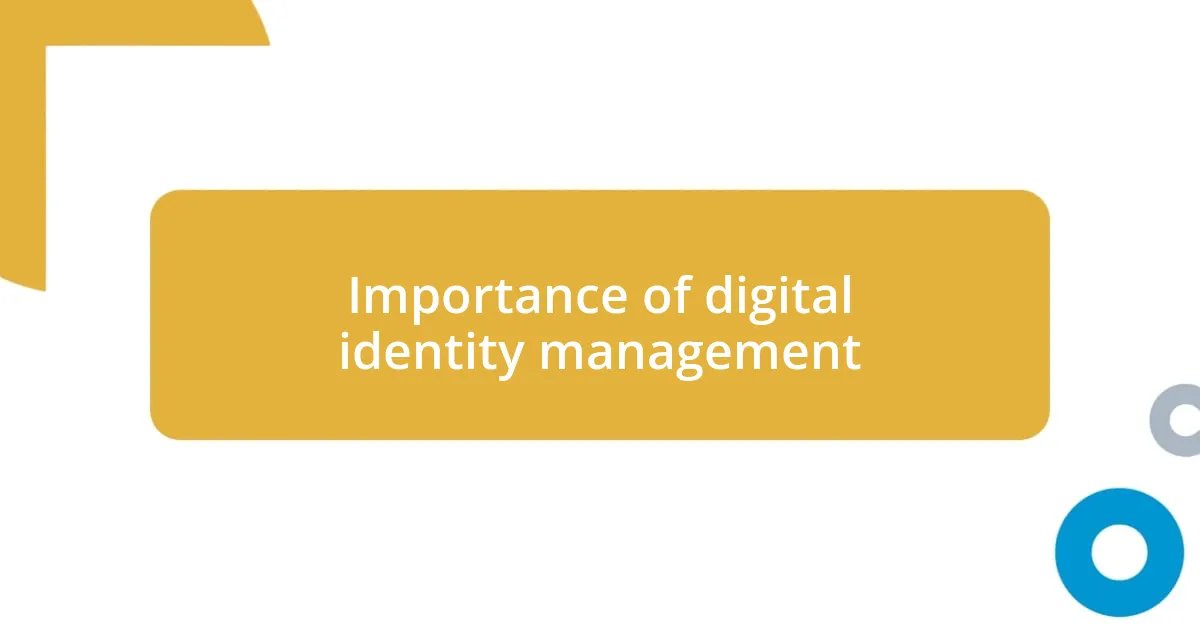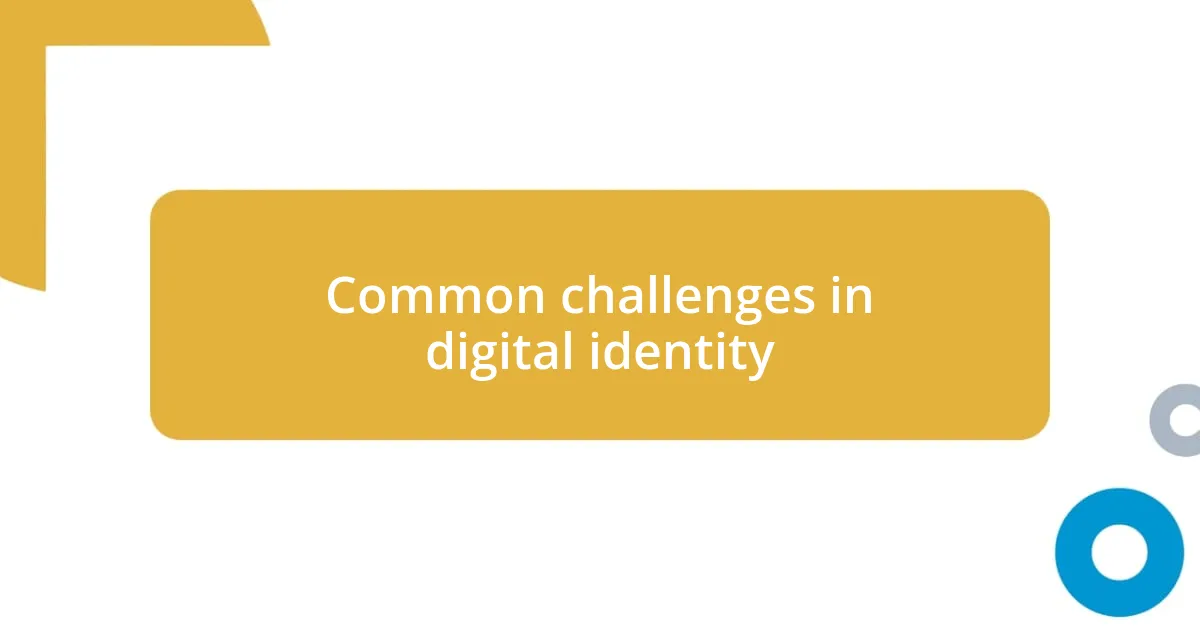Key takeaways:
- Digital identity is shaped by online behaviors, interactions, and shared content, creating a multifaceted narrative about an individual.
- Managing digital identity is essential for personal and professional opportunities and requires awareness of security measures to prevent identity theft.
- Utilizing tools like password managers and two-factor authentication enhances security and confidence in managing one’s digital presence.
- Challenges include maintaining a consistent online presence, managing excessive personal information sharing, and keeping up with changing privacy regulations.

Understanding digital identity concepts
When I first started navigating my digital identity, I was surprised by how much information about me was readily available online. Each post, comment, and image contributes to this intricate tapestry of who I am, leaving me to wonder: how much control do I really have over my own narrative? This realization hit me hard during a routine Google search—I was shocked by the results that popped up, some of which I had long forgotten.
Understanding the core concepts of digital identity is crucial. It encompasses not just the profiles we create on social media, but also our online behaviors, interactions, and the data we generate daily. Looking back, I remember effortlessly posting a status update but rarely considering the long-term implications of how it might paint a picture of my personality or values.
One significant aspect that stood out to me is the idea of digital footprints—each action I take online leaves a mark. Early on, I made the mistake of sharing too much personal information on forums, which, quite frankly, made me anxious about my privacy. I learned that curating my online presence is not just about showcasing the good parts, but also about being mindful of what I leave behind. Doesn’t it make you pause and think about how your digital identity shapes perceptions of you?

Importance of digital identity management
Digital identity management is incredibly important because it directly impacts our personal and professional lives. I recall a time when a potential employer conducted a background check on me and referred to my social media activity. It struck me how a single meme I’d posted years ago could influence my job prospects. This realization helped me understand that managing my digital identity is not merely an option; it’s a necessity.
One often-overlooked aspect is the security of our personal data. I remember the stress I felt after discovering that a friend’s account had been hacked due to weak password management. The fallout taught me that without proper digital identity management, we risk exposing ourselves to identity theft or fraud. Protecting my online accounts has since become a priority, and I continually modify my practices to adapt to the evolving digital landscape.
Moreover, maintaining a consistent and authentic online persona fosters trust. In my own experience, I’ve noticed that being transparent about my professional journey has allowed others to connect with me on a more meaningful level. When I share my challenges and successes, it creates a genuine narrative that resonates with others. Isn’t it comforting to know that a carefully managed digital identity can enhance our relationships, both online and offline?
| Aspect | Significance |
|---|---|
| Personal Branding | Shapes how others perceive you, influencing opportunities. |
| Security | Protects against identity theft and fraud. |
| Authenticity | Fosters trust and builds connections. |

Tools for effective identity management
Managing my digital identity effectively requires the right tools, and I’ve learned that these resources can truly make a difference. For instance, I’ve used password managers, which not only simplify the process of keeping track of my numerous accounts but also offer security features like strong password generation. I remember the initial reluctance I had to adopt one, feeling it would be complicated. However, once I started using it, the peace of mind knowing my passwords were both strong and stored safely was an absolute game changer.
Here’s a list of tools that can enhance your digital identity management:
- Password Managers (e.g., LastPass, 1Password): Securely store and manage passwords against potential breaches.
- Identity Theft Protection Services (e.g., LifeLock, IdentityGuard): Monitor your personal information and alert you to potential identity theft.
- Social Media Management Tools (e.g., Hootsuite, Buffer): Help curate and schedule your online presence for consistency.
- VPN Services (e.g., NordVPN, ExpressVPN): Protect your online activities from prying eyes, enhancing your privacy.
- Two-Factor Authentication (2FA): Adds an extra layer of security to your accounts, making unauthorized access more difficult.
As I explored these options, I felt a growing sense of empowerment. It’s incredible how these tools helped shift my perspective from feeling vulnerable online to a more confident stance. Once, after activating two-factor authentication on my social media accounts, I felt a sigh of relief wash over me. Knowing that my accounts had an extra layer of protection was just what I needed to reinforce my digital boundaries. The right tools can transform not just how we manage our identity, but how we feel about it too.

Common challenges in digital identity
Navigating digital identity can be quite daunting, and I’ve faced several common challenges along the way. One issue that stands out to me is the difficulty in maintaining a consistent online presence. I often find myself questioning: How do I balance being authentic with being professional? Honestly, it’s a fine line. I’ve had moments when I wanted to share something personal, but hesitated, worried it might not align with my professional image. This internal tug-of-war can lead to anxiety over how I’m perceived online.
Another challenge is the overwhelming amount of personal information we share. I recall a time when I casually shared a location tag while on vacation. Little did I know, this could open the door to unwanted attention. It made me realize how easy it is for our digital footprint to spiral out of control. I now actively think about what I post and ask myself if it’s worth the risk. After all, the internet never forgets, right?
Lastly, keeping up with evolving privacy regulations feels like a constant uphill battle. Just when I had gotten comfortable with one set of guidelines, new rules emerge. I remember feeling frustrated during a recent update to privacy policies on a platform I use. It left me wondering: How can anyone truly manage their digital identity with all these changes? I’ve found it crucial to stay informed, yet I often wish there were simpler, more streamlined ways to navigate this landscape. It can feel like a never-ending game of catch-up, which is exhausting but necessary.














